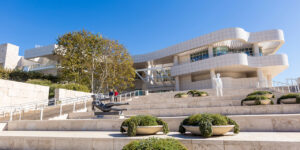In the early morning of the 16th of December 1997, a large number of people lined up at the entrance of the Getty Center to look forward to the grand, well-known art museum which would be opening its doors to the public for the first time.
The Los Angeles Times reported, “For decades, a lot of them had driven through the freeway looking upwards to view this gorgeous spot on the hill slowly rise in pieces.” As the sun rose, it had just begun to rise, and many guests had already arrived hours earlier. The cold did not appear to be a problem for them; the excitement was keeping spirits high. The staff offered fresh, free coffee to keep guests warm.
The visitors started arriving at 10am and getting on this tram and taking the 5-minute journey through the hills. They enjoyed the stunning panorama of L.A. and the city’s skyline. When they arrived at the arrival plaza and being in awe of more views–ocean city, canyon — all with Richard Meier’s breathtaking architectural design. The building’s surfaces are covered with more than 300,000 cream-colored travertine blocks sourced from a quarry close to Rome.
In the course of the day guests walked the paths and walked through the flowering trees, water, and elements in the Central Garden, which Robert Irwin created as a sculpture. The five pavilions of the gallery which were mostly of the pre-20th century art by Rembrandt, Van Gogh, and Cezanne among others were lit with natural light exactly as the artists had planned, and five first exhibitions were open for viewing. The Getty was the focus of attention for many visitors. their connection to the Getty Conservation Institute, Getty Research Institute as well as the Getty Foundation, programs that were scattered throughout L.A. and were brought together in a 24 acre campus following J. Paul Getty’s passing. Visitors could also view an orientation movie that provided more details about the history of the Getty, and also the documentary Art Works: Behind the Scenes at the Getty.
Community Arts Resources (CARS) organized 14 shows by artists from the diverse culture that is Los Angeles, and visitors were treated to taiko, Filipino, Hawaiian, and Indian dance performances mariachi music, Cuban salsa and the high school gospel choir and storytellers from all over the world and seven art workshops and much more. CARS also requested giant puppets based off figures from the Getty collection painting by James Ensor, Christ’s Entry into Brussels in 1889. Then, they organized a parade that featured the puppets and participants from the making of carnival masks.
Visitors may be able to see famous actors like Denzel Washington or Diane Keaton, artists like Ed Ruscha, and L.A.’s mayor of this time Richard Riordan, all present for the grand opening celebrations. Riordan addressed the crowd, “The new Getty Center is a symbol of our city’s Renaissance. It is expected to boost the tourism industry, create jobs and contribute to Los Angeles’s booming economy. The Center will also make an enormous difference to the cultural landscape of Los Angeles by providing youngsters Angelenos access to education resources and igniting their artistic passion and creativity.” East L.A. rock group Los Lobos, known for the smash hit song “La Bamba,” performed to the audience and hundreds of reporters were on hand to capture reaction of Center’s initial guests. The media would refer to the Center as an “stupendous new castle of classic beauty,” “a cultural fortress,” and “the house which art has built.”
Since the day it was inaugurated it has been the Center has hosted around 20 million people who have came from all over the world to visit and see more than 453 exhibitions and provided a myriad of lectures, concerts, classes as well as symposia and open-to-the-public programs for free. For those who are like Suzanne Muchnic, who reported on the opening ceremony of the Center with The Los Angeles Times, the website has played a crucial contribution to her professional and personal life.
“As an editor for The Times I’ve enjoyed the pleasure of going to the cave temples of Mogao in west China and Saint Catherine’s Monastery in Sinai for reporting on Getty conservation initiatives that have resulted in spectacular exhibitions. When I was working from home, I depended upon Getty for an inexhaustible variety of topics–new acquisitions art exhibitions in development research projects, and experts to speak with. In my personal life, I go to the Getty Center to experience the joy of looking at and contemplating unusual things.”
In her reflections on its first experience at the Center, Muchnic says, “I recall being amazed it was a good thing that the J. Paul Getty Museum was now more than just a treasure hidden away in the outskirts of Malibu. With its contemporary buildings perched on a hill, which overlooked the sprawling city of Los Angeles, the Museum and its vastly expanded collection became the artistic core of a global cultural complex, including research and conservation institutes that could draw a diverse group of scholars and visitors.”
In 1997, as Muchnic stated in her Times report of 1997 “there is nothing more like Getty Center.” Getty Center.”


Recent Comments